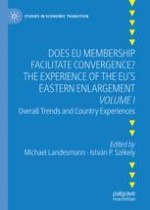2021 | OriginalPaper | Chapter
5. How the European Union Made Poland European Again
Author : Marcin Piatkowski
Published in: Does EU Membership Facilitate Convergence? The Experience of the EU's Eastern Enlargement - Volume I
Publisher: Springer International Publishing
Activate our intelligent search to find suitable subject content or patents.
Select sections of text to find matching patents with Artificial Intelligence. powered by
Select sections of text to find additional relevant content using AI-assisted search. powered by
